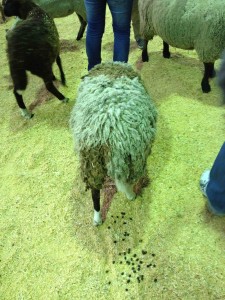Escherichia coli O157:H7 is a globally important foodborne pathogen and has been mainly associated with cattle as the reservoir. However, accumulating data shows the importance of sheep as an E. coli O157:H7 vehicle.
 The presence of E. coli O157/O157:H7 in recto-anal mucosal swap and carcass sponge samples of 100 sheep brought to the slaughterhouse in Kirikkale were analyzed over a year. Molecular characteristics (stx1, stx2, eaeA, hly, lpfA1-3, espA, eae-α1, eae-α2, eae-β, eae-β1, eae-β2, eae-γ1, eae-γ2/θ, stx1c, stx1d, stx2c, stx2d, stx2e, stx2f, stx2g, blaampC, tet(A), tet(B), tet(C), tet(D), tet(E), tet(G), sul1, sul2, floR, cmlA, strA, strB and aadA) of 79 isolates were determined and minimum inhibitory concentrations of 20 different antibiotics were investigated. E. coli O157/O157:H7 was found in 18% of sheep included in the study and was more prevalent in yearlings than lambs and mature sheep, and male than female sheep, though none of the categories (season, sex or age range) had significant effect on prevalence. Furthermore, Shiga-toxigenic E. coli (STEC) O157:H7 was determined in 2% and 8% of sheep feces and carcasses, respectively. Additionally, lpfA1-3 and eae-γ1 were detected in all isolates. None of the isolates showed resistance against investigated antibiotics, even though 4 sorbitol fermenting E. coli O157 isolates were positive for tet(A), sul1 and aadA. This is the first study in Turkey that reveals the potential public health risk due to the contamination of sheep carcasses with potentially highly pathogenic STEC O157:H7 strains.
The presence of E. coli O157/O157:H7 in recto-anal mucosal swap and carcass sponge samples of 100 sheep brought to the slaughterhouse in Kirikkale were analyzed over a year. Molecular characteristics (stx1, stx2, eaeA, hly, lpfA1-3, espA, eae-α1, eae-α2, eae-β, eae-β1, eae-β2, eae-γ1, eae-γ2/θ, stx1c, stx1d, stx2c, stx2d, stx2e, stx2f, stx2g, blaampC, tet(A), tet(B), tet(C), tet(D), tet(E), tet(G), sul1, sul2, floR, cmlA, strA, strB and aadA) of 79 isolates were determined and minimum inhibitory concentrations of 20 different antibiotics were investigated. E. coli O157/O157:H7 was found in 18% of sheep included in the study and was more prevalent in yearlings than lambs and mature sheep, and male than female sheep, though none of the categories (season, sex or age range) had significant effect on prevalence. Furthermore, Shiga-toxigenic E. coli (STEC) O157:H7 was determined in 2% and 8% of sheep feces and carcasses, respectively. Additionally, lpfA1-3 and eae-γ1 were detected in all isolates. None of the isolates showed resistance against investigated antibiotics, even though 4 sorbitol fermenting E. coli O157 isolates were positive for tet(A), sul1 and aadA. This is the first study in Turkey that reveals the potential public health risk due to the contamination of sheep carcasses with potentially highly pathogenic STEC O157:H7 strains.
Yilmaz Emre Gencay
